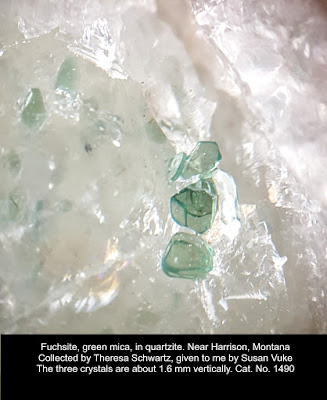Fuchsite is a chromium-bearing variety of the mica muscovite,
K(Al,Cr)3Si3O10(OH)2 . Chromium gives the green color to the muscovite.
This specimen was collected by Theresa Schwartz and given to
me by Susan Vuke. Theresa reports it was a clast in a pediment near Little
Antelope Valley, northwest of Harrison, Montana. That leaves the question open
as to where it formed and came from, but a source in the Tobacco Root Mountains
is most likely. The pediment gravel itself was probably deposited fairly
recently, the last 50 million years or so, a result of the uplift of the
Tobacco Roots. There are at least two chromite occurrences regionally nearby, 3
miles southwest of Silver Star (in the Highlands Mountains), and 5 miles
southeast of Sheridan (southwestern Tobacco Roots) (Chadwick, 1941 Montana Tech
thesis).
A reasonable idea for the protolith is a well-sorted, clean,
quartz sandstone, with a very few resistant detrital chromite grains that
during metamorphism had the chromium mobilized to find potassium and aluminum
impurities from wherever you want to form the mica. The chromite could have come
(with obvious challenges and difficulty) from the Stillwater Complex, the
chromite- and platinum-rich ultramafic deposit on the north flank of the
Beartooth Mountains, supposing some fluvial system to transport the sand that
became this quartzite. That could have been a Precambrian river system, eroding
either from what is now the Beartooths to the east or from the minor chromite occurrences
to the west.
Fuchsite was named in 1842 by Karl F. Emil von
Schafhäutl in honor of Johann Nepomuk von Fuchs [May 15, 1774 Mattenzell, near
Bremberg, Lower Bavaria, Germany - March 5, 1856 Munich, Germany] professor of
chemistry and mineralogy at University of Landshut and curator of the
mineralogy collection. (from MinDat)

No comments:
Post a Comment